Traditionally, when someone visualised talking therapy, they would imagine the client reclining on a couch, pouring their heart out whilst the therapist sat and made notes.
Nowadays both our perception, and the reality, has changed considerably. We have moved to the very professional relationship between the Therapist and Client, where the Therapist is trained, qualified and monitored in the latest techniques and the Client can discuss issues over a number of sessions, reaching resolution and closure.
A major issue for all of us today is time and place. With full time jobs, family and other commitments, clients find it harder and harder to fit things in, and that naturally extends to therapy.
Last year the Office of National Statistics published the following statistics:
– In 2014, 38 million adults (76%) in Great Britain accessed the Internet every day
– In 2014, 74% of all adults bought goods or services online
– In Great Britain, 22 million households (84%) had Internet access in 2014, up from 57% in 2006.
We undertake a vast range of activities online, and it’s only natural that therapy now features as one of those activities. To be clear: by online we are typically talking about email, instant messaging, and Skype or similar technologies.
There are of course some clear pros and cons of online therapy:
Pros
– It offers people in rural or remote areas better access to mental health support.
– It also gives access to those who are disabled or housebound.
– Online therapy is usually fairly affordable and convenient.
– Online therapy may also be effective in eliminating the social stigma associated with receiving therapy.
Cons
– Some insurance policies do not cover online therapy.
– There are understandable concerns about confidentiality, privacy and unreliable technology.
– Therapists may not be able to respond to crisis situations.
– Online therapy is not appropriate for those with serious psychiatric illnesses.
– The therapist may not be able to see facial expressions, vocal signals or body language.
Summary
Online therapy has its challenges, that carefully need to be thought about and addressed. However, it also has huge benefits for the public and private sector, client and therapist alike.
In our next article we will look deeper into the pros and cons and consider how the future may look.
This article was written by Suheyla Hussein a Chartered Counselling Psychologist & CBT Therapist, and John Berman a Technologist.


